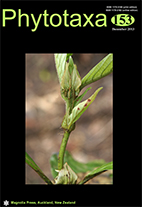Abstract
Recent surveys of the epilithic diatoms of Réunion Island led to the discovery of three new species: Crucicostulifera bebourensis, Encyonopsis cilaosensis, Encyonopsis palmeti. Crucicostulifera bebourensis is the second species to be included in this recently described genus typified by Crucicostulifera areolata (Hustedt) Taylor & Lange-Bertalot. Both species share the main diagnostic features of the genus. However, Crucicostulifera bebourensis differs from Crucicostulifera areolata (Hustedt) Taylor & Lange-Bertalot in the cingulum composed of at least three open bands whereas the latter species has a single valvocopula on each valve. Encyonopsis cilaosensis and Encyonopsis palmeti can be differentiated from other Encyonopsis species by a combination of characters including valve outline, number of striae in l0 µm, maximum length/breadth ratio, areolae structure and presence or absence of intermissio. Both new species show a particular organization of the cingulum. Crucicostulifera bebourensis occurs in acidic waters with very low conductivity and nutrient concentration. Encyonopsis cilaosensis is found in alkaline waters with high conductivity whereas Encyonopsis palmeti is reported from slighty alkaline waters with low conductivity.

